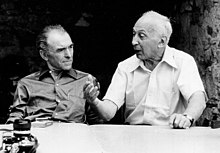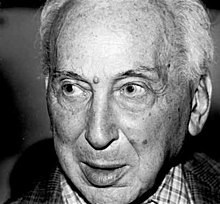André Kertész

André Kertész (* July 2, 1894 in Budapest , Austria-Hungary , as Andor Kertész ; † September 27 or 28, 1985 in New York City ) was a photographer from Hungary who was considered to be a style-maker in artistic photography for several decades . In his work today the periods Hungary (from 1912), Paris (from 1926) and New York (from 1936) are distinguished.
Life
Hungary
Born in Budapest as the son of the Jewish bookseller Lipót Kertész and his wife Ernesztin, b. Hoffmann , born middle of three sons, called “Bandi”, was to enter the banking business at the father's request. He graduated from the commercial academy by 1912 and began working on the stock exchange. In 1912 he bought his first camera, an ICA -4.5 × 6 box. In the First World War he served from 1914 to 1918 and documented the war with a Tenax 4.5 × 6 cm camera. In 1916 he won the first prize for a self-portrait and in 1917 his first photos appeared in the magazine Érdekes Újság . In 1918, most of his negatives (back then on glass) and prints were lost.
Paris
In 1925 he moved to Paris and began taking photos for magazines. His work has appeared in the Frankfurter Illustrierte , the London Times and the Berliner Illustrirten Zeitung , among others . In 1927 he showed his pictures for the first time in a solo exhibition at the Au Sacre du Printemps gallery in Paris. With the proceeds he bought his first Leica. In 1928 he met Brassaï , who supported him for some time with his reports. In the same year he took part, together with Man Ray and Nadar , at the Salon de l'Escalier, the premier Salon Indépendant de Photographie in the Théâtre des Champs-Élysées and took up his work for that of Lucien Vogel (1886-1954) founded photo magazine VU . In 1929 the State Museums and Art Library in Berlin and the König Albert Museum in Zwickau acquired the photographer's first works.
new York
In 1936 Kertész emigrated to the United States and from then on worked for magazines such as Vogue and Harper's Bazaar . In 1944 he was naturalized. After the US troops liberated France, he tried to transfer his negatives from Paris to the USA, but as after the First World War, most of his negatives were destroyed. From 1949 to 1962 Kertész worked almost exclusively for products from the Condé-Nast publishing house in New York City . After a serious illness he ended his permanent engagement in 1962, but remained artistically active until shortly before his death.
Kertész was later honored with numerous honors. Among other things, he received an honorary doctorate from the Royal College of Art and became a member of the Legion of Honor in 1983 .
plant
In the nude photography of the 1920s he went idiosyncratic ways with his famous distortions by photographing his models with the help of distorting mirrors in striking (and at the time often little appreciated) views.
His product photography was also groundbreaking , for example Mondrian's glasses or Die Gabel , which have become incunabula in the history of photography because of their clear simplicity . No less well known are many views of pre-war Paris and street life back then.
Always in black and white, he has graphically produced striking and often surprising views of everyday situations: be it people taken vertically from above with long shadows, traces of vehicles in the freshly fallen snow or an artistically placed curb with remains of snow that no one would consider worthy of a photo would consider. The picture of a sleeping gypsy boy is considered to be his first surviving work.
literature
- André Kertész. Moments of a lifetime. Kehl 1982, ISBN 3-89507-200-1 . (A representative cross-section of a 70-year career in 150 pictures.)
- Hans-Michael Koetzle: Photo Icons, Volume 2. Taschen-Verlag, ISBN 3-8228-1829-1 .
- Reinhold Misselbeck : André Kertész. In: Photography of the 20th Century. Museum Ludwig Cologne . Cologne 1996, ISBN 3-8228-8818-4 .
- Michel Frizot, Annie-Laure Wanaverbecq: André Kertész. Hatje Cantz, Ostfildern 2010, ISBN 978-3-7757-2630-6 . (Monograph and exhibition catalog. Galerie Nationale du Jeu de Paume, Paris, September 28, 2010 - February 6, 2011; Fotomuseum Winterthur, February 26, 2011 - May 15, 2011; Martin-Gropius-Bau, Berlin, June 11, 2011 - September 11, 2011; Hungarian National Museum , Budapest, September 30, 2011 - December 31, 2011.)
Exhibitions
- André Kertész . Retrospective of Kertész's oeuvre at the Fotomuseum Winterthur from February 26th to May 24th, 2011
- André Kertész. Photographs . in the Martin-Gropius-Bau in Berlin from June 11th to September 11th, 2011
Web links
- Literature by and about André Kertész in the catalog of the German National Library
- André Kertész at photography-now.com
The following websites with examples of works are all in English:
- André Kertész: Seven Decades Exhibition at the Getty Center, NY 2008.
- André Kertész: Life and Its Juxtaposition's biography and several works
- The National Gallery of Art, Washington .
- Annotated portfolio with 20 works from 1914 .
Individual evidence
- ↑ Tim N. Gidal , Germany - Beginning of Modern Photojournalism , Bucher, Lucerne, 1972, ISBN 3-7658-0152-6 , p. 93
- ↑ biography (French)
- ↑ http://www.fotomuseum.ch/index.php?id=21 (link not available)
- ^ André Kertész - photographs . berlinerfestspiele.de. Retrieved July 24, 2011.
| personal data | |
|---|---|
| SURNAME | Kertész, André |
| ALTERNATIVE NAMES | Kertész, Andor (maiden name) |
| BRIEF DESCRIPTION | Hungarian photographer |
| DATE OF BIRTH | July 2, 1894 |
| PLACE OF BIRTH | Budapest , Hungary |
| DATE OF DEATH | September 27, 1985 or September 28, 1985 |
| Place of death | New York City |
